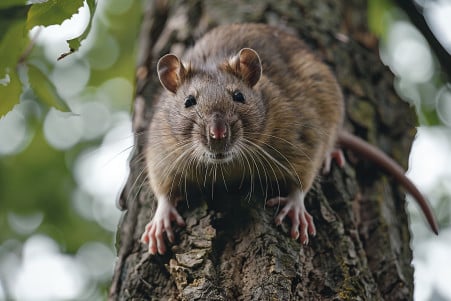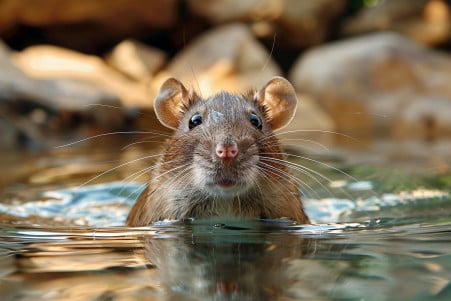Do Rats Climb Walls? The Science Behind Their Impressive Climbing Prowess
28 February 2024 • Updated 27 February 2024

Rats are known for their ability to survive, but you may not realize just how good they are at climbing walls. Thanks to their sharp claws and flexible bodies, rats are excellent climbers that can easily scale rough surfaces like walls, trees, and pipes. Roof rats, in particular, are especially good at climbing vertical surfaces. Norway rats are also good climbers, but they tend to stick to lower levels.
This article will cover research from zoology, urban ecology, and pest management to explain the amazing climbing abilities of rats. It will provide information from studies on rat biology, behavior, and adaptations to their environment that help them climb walls. The goal is to not only satisfy your curiosity but also to help you understand how to deal with these resilient urban animals.
Do rats climb walls?
The Biomechanics of Rat Climbing: An Anatomical Viewpoint
Rats have a number of anatomical features that allow them to be excellent climbers, which is important for their survival in a range of ecosystems. Studies that have looked at the climbing abilities of rats have shown that rats use their sharp claws to grip rough surfaces.
Rats’ tails are used for balance and are also muscular and flexible, acting as an extra limb to help stabilize them while they climb. Pads on their feet help them grip by providing friction, which allows them to climb up and stay on vertical surfaces without sliding off.
From a physiological standpoint, research has shown that rats have an impressive metabolic rate. This, along with an enlarged heart and advanced respiratory system, enables rats to have the stamina to climb for long periods of time and over long distances. Studies that have looked at tree-climbing have shown that roof rats, also known as black rats, are especially well-suited to life in the trees and are more agile climbers than Norway rats.
While these anatomical and physiological adaptations help rats climb, they also help rats in other activities, such as swimming and jumping, showing that rats are adaptable in a number of ways. This adaptability is important for rats to escape predators and find food in the many different ecosystems they inhabit, both in the wild and in urban areas.
The Science Behind Rats’ Ability to Climb
In addition to their physical attributes, rats also demonstrate behavioral prowess when climbing. These intelligent animals use their problem-solving abilities to figure out the best ways to climb, a skill that Pest Informer says is a sign of their intelligence. Driven by the need to survive and escape predators or find food, rats have learned to climb in complex ways through trial and error.
This learning allows them to quickly and easily learn and remember the best way to climb a structure, according to A-Z Animals. Different surfaces offer different challenges, and rats adapt their climbing techniques to meet them. For example, while rough surfaces like brick and wood can be climbed using their sharp claws, smooth surfaces require a different approach, often using their strong hind legs and tail to help them gain traction and balance.
In addition, the availability of food and shelter and the presence of danger can also impact rats’ climbing. For example, in urban environments, where food sources may be located on rooftops or inside buildings, rats have been shown to be especially adept at climbing walls, according to Eliminate Solutions. Understanding these behaviors is important when it comes to preventing rodent infestations and shows the importance of a comprehensive approach to pest control.
Understanding the Role of the Environment in Rat Vertical Movement
The urban environment is full of different obstacles that rats must overcome to move up and down buildings. The different materials used in building construction can have a direct impact on rats’ ability to climb; for example, an environmental assessment published on PMC by Phipatanakul et al. notes that rats can climb a variety of vertical surfaces, including wood and brick, thanks to their sharp claws and agility.
However, rats have a harder time climbing smooth surfaces, like glass, which could limit their ability to move between different parts of a building.
The weather can also impact rats’ ability to climb. Extreme temperatures can impact rats’ metabolism, which could impact their physical ability to climb.
A variety of urban structures, from power lines to the way pipes are arranged, can create opportunities for rats to move up and down buildings. Scientific Reports published a study that explains how these urban environments also create a variety of nooks and crannies that make it easier for rodents to climb.
Human changes to the environment can also make it easier or harder for rats to move up and down buildings. PMC explains that integrated pest management strategies, which include things like sealing entry points and reducing harborage, can impact rats’ ability to climb and access buildings.
Understanding how these environmental factors impact rats’ ability to climb is important for urban planners and pest management professionals who want to limit the impact of rats’ agile climbing in cities.
Outsmarting the Acrobatic Rat: Pest Control Methods
One of the most important ways to outsmart the acrobatic abilities of rats is to employ an Integrated Pest Management (IPM) strategy.
The School Integrated Pest Management program details this approach, which uses a combination of sanitation, building exclusion, and control methods to keep pest populations at bay.
Physical exclusion, which includes sealing up any openings that are larger than 1/4 inch for mice and 1/2 inch for rats, is important to keep these agile climbers at bay.
Trapping and baiting are also important parts of IPM. The IPM Action Plan for Rodents suggests that placing bait blocks and snap traps along rat runways will lead to a significant reduction in rats.
It’s also important to note that roof rats, which are attracted to fruit and nuts, and Norway rats, which prefer fish or meat, will require different baiting strategies to account for their different preferences. The key to these methods is to make sure that they are implemented in a way that’s strategic and that they are monitored and adjusted regularly to account for rats’ neophobic tendencies.
Keeping climbing rat populations in check will require regular monitoring and adjusting of strategies, which means that it will require constant vigilance in looking for signs of rodent activity in the environment. As urban ecosystems continue to change, pest control methods will need to change with them, always ready to adapt to the ever-changing and resourceful nature of rats.
Sensory and Motor Systems in Climbing
Rats use a complex sensory system to help them become expert climbers. In particular, the sense of touch and proprioception, or the ability to understand where one’s body is in space, are important for moving around on vertical surfaces.
When rats climb, their somatosensory cortex is activated to process tactile information, which is important for coordinating movement and maintaining balance. According to a paper in PubMed, a study by Ian E. Brown, the cerebellum, which is closely linked to the somatosensory system, helps to adjust the timing of responses to tactile stimuli, which ultimately helps the rats become better climbers.
The motor cortex is also involved in climbing, helping to coordinate the specific muscle movements that are needed to make agile movements. It’s through this complex network that rats are able to perform the movements they need to climb.
In addition, the rats’ whiskers, or vibrissae, are also important for helping them understand where they are in space. An article in Scholarpedia explains that through vibrissal behavior, rats use their whiskers to sense the texture of surfaces and detect obstacles, which helps them maintain their balance and successfully navigate their environment.
This sensory information helps them decide how to move next, whether that’s a slight adjustment in their position or a leap to the next handhold. By combining sensory information with motor systems, rats are able to show a remarkable ability to move through and conquer the vertical world around them.
Climbing to Conclusions: The Urban Rat
As we have seen, rats are incredibly adept climbers, and their ability to scale vertical walls is the result of a combination of anatomical, behavioral, and sensory and neurological traits. Both roof rats, which have evolved to be climbing specialists, and Norway rats, which have evolved to be more selective climbers, show impressive climbing abilities that make them difficult to control as urban pests.
Understanding these traits is key to developing effective pest control methods. By using physical barriers in combination with an understanding of rat behavior and the environmental factors that influence it, we can build better defenses against these highly adaptable animals. This is especially important as urban areas continue to grow and change, making the need for new pest control methods increasingly urgent.
Ongoing research and development in this area is needed to keep up with these highly adaptable urbanites. Their ability to adapt is a sign of the constant change in urban ecosystems and the ongoing war between human technology and the rat’s biological imperative.
In the end, the nimble urban rat is a perfect example of the complex interplay between biology and environment, and while we can admire its resourcefulness, we must also work to overcome it in the name of public health and sanitation.


